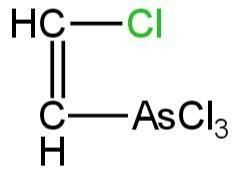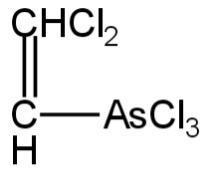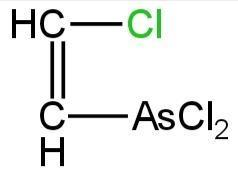
Structural formula for lewisite is
A.

B.

C.

D. None of these
Answer
218.7k+ views
Hint: A molecule of AsCl3 gets added to acetylene giving lewisite. It is an organoarsenic compound i.e., including organic units, ethene, and arsenic. It was employed by many countries for its usage as a chemical weapon, behaving as a blister agent and lung irritant.
Complete Step by Step Solution:
Lewisite is a compound that is readied by the addition of a molecule of arsenic trichloride to acetylene in the presence of a desirable catalyst.
This catalyst mainly is aluminium chloride.
\[AsC{l_3} + {C_2}{H_2} \to ClCHCHAsC{l_2}\]
Lewisite undergoes hydrolysis in water to form hydrochloric acid and chlorovinyl arsenious oxide which is a less strong blister agent.
\[{\rm{ClCHCHAsC}}{{\rm{l}}_{\rm{2}}}{\rm{ + 2}}{{\rm{H}}_{\rm{2}}}{\rm{O}} \to {\rm{ClCHCHAs}}{\left( {{\rm{OH}}} \right)_{\rm{2}}}{\rm{ + 2 HCl}}\]
This reaction is quickened by alkaline solutions and forms acetylene and trisodium arsenate.
Lewisite reacts with metals to yield hydrogen gas. It is combustible, but difficult to ignite.
It is an arsenic-based compound that was formulated to be a powerful chemical to be used in the war.
Susceptibility to lewisite commonly influences the eyes, skin, and respiratory tract which happen nearly immediately after the following contact.
As a chemical combat agent, it can be circulated as a liquid, aerosol, or vapour and can be utilised to provoke fatalities and for area denial.
So, the chemical formula of lewisite is\[ClCHCHAsC{l_2}\]. So, its structure is C.
So, option C is correct.
Note: Lewisite was made in 1904 by Julius Arthur Nieuwland during research for his Ph.D. In his thesis, he depicted a reaction between acetylene and arsenic trichloride, which guided the formation of lewisite. Revelation to the ensuing compound made Nieuwland so sick he was in the hospital for many days.
Complete Step by Step Solution:
Lewisite is a compound that is readied by the addition of a molecule of arsenic trichloride to acetylene in the presence of a desirable catalyst.
This catalyst mainly is aluminium chloride.
\[AsC{l_3} + {C_2}{H_2} \to ClCHCHAsC{l_2}\]
Lewisite undergoes hydrolysis in water to form hydrochloric acid and chlorovinyl arsenious oxide which is a less strong blister agent.
\[{\rm{ClCHCHAsC}}{{\rm{l}}_{\rm{2}}}{\rm{ + 2}}{{\rm{H}}_{\rm{2}}}{\rm{O}} \to {\rm{ClCHCHAs}}{\left( {{\rm{OH}}} \right)_{\rm{2}}}{\rm{ + 2 HCl}}\]
This reaction is quickened by alkaline solutions and forms acetylene and trisodium arsenate.
Lewisite reacts with metals to yield hydrogen gas. It is combustible, but difficult to ignite.
It is an arsenic-based compound that was formulated to be a powerful chemical to be used in the war.
Susceptibility to lewisite commonly influences the eyes, skin, and respiratory tract which happen nearly immediately after the following contact.
As a chemical combat agent, it can be circulated as a liquid, aerosol, or vapour and can be utilised to provoke fatalities and for area denial.
So, the chemical formula of lewisite is\[ClCHCHAsC{l_2}\]. So, its structure is C.
So, option C is correct.
Note: Lewisite was made in 1904 by Julius Arthur Nieuwland during research for his Ph.D. In his thesis, he depicted a reaction between acetylene and arsenic trichloride, which guided the formation of lewisite. Revelation to the ensuing compound made Nieuwland so sick he was in the hospital for many days.
Recently Updated Pages
Is PPh3 a strong ligand class 12 chemistry JEE_Main

Full name of DDT is A 111trichloro22bispchlorophenyl class 12 chemistry JEE_Main

Sodium acetate on heating with soda lime produce A class 12 chemistry JEE_Main

Find the isoelectric point pI of Lysine A 556 B 974 class 12 chemistry JEE_Main

The order of basicity among the following compounds class 12 chemistry JEE_Main

The number of isomers in C4H10O are a7 b8 c6 d5 class 12 chemistry JEE_Main

Trending doubts
JEE Main 2026: Application Form Open, Exam Dates, Syllabus, Eligibility & Question Papers

Derivation of Equation of Trajectory Explained for Students

Hybridisation in Chemistry – Concept, Types & Applications

Understanding the Angle of Deviation in a Prism

Understanding Collisions: Types and Examples for Students

Understanding Atomic Structure for Beginners

Other Pages
NCERT Solutions For Class 12 Chemistry Chapter 1 Solutions - 2025-26

NCERT Solutions for Class 12 Chemistry Chapter Chapter 7 Alcohol Phenol and Ether

NCERT Solutions ForClass 12 Chemistry Chapter Chapter 8 Aldehydes Ketones And Carboxylic Acids

JEE Advanced Marks vs Ranks 2025: Understanding Category-wise Qualifying Marks and Previous Year Cut-offs

Haloalkanes and Haloarenes Class 12 Chemistry Chapter 6 CBSE Notes - 2025-26

Solutions Class 12 Chemistry Chapter 1 CBSE Notes - 2025-26




